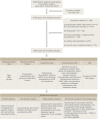Correlation between perioperative dexmedetomidine administration and postoperative acute kidney injury in hypertensive patients undergoing non-cardiac surgery
- PMID: 37063282
- PMCID: PMC10090366
- DOI: 10.3389/fphar.2023.1143176
Correlation between perioperative dexmedetomidine administration and postoperative acute kidney injury in hypertensive patients undergoing non-cardiac surgery
Abstract
Background: Previous studies have suggested that dexmedetomidine may have a protective effect on renal function. However, it is currently unclear whether perioperative dexmedetomidine administration is associated with postoperative acute kidney injury (AKI) incidence risk in hypertensive patients undergoing non-cardiac surgery. Methods: This investigation was a retrospective cohort study. Hypertensive patients undergoing non-cardiac surgery in Third Xiangya Hospital of Central South University from June 2018 to December 2019 were included. The relevant data were extracted through electronic cases. The univariable analysis identified demographic, preoperative laboratory, and intraoperative factors associated with acute kidney injury. Multivariable stepwise logistic regression was used to assess the association between perioperative dexmedetomidine administration and postoperative acute kidney injury after adjusting for interference factors. In addition, we further performed sensitivity analyses in four subgroups to further validate the robustness of the results. Results: A total of 5769 patients were included in this study, with a 7.66% incidence of postoperative acute kidney injury. The incidence of postoperative acute kidney injury was lower in the dexmedetomidine-administered group than in the control group (4.12% vs. 8.06%, p < 0.001). In the multivariable stepwise logistic regression analysis, perioperative dexmedetomidine administration significantly reduced the risk of postoperative acute kidney injury after adjusting for interference factors [odds ratio (OR) = 0.56, 95% confidence interval (CI): 0.36-0.87, p = 0.010]. In addition, sensitivity analysis in four subgroups indicated parallel findings: i) eGRF <90 mL/min·1.73/m2 subgroup (OR = 0.40, 95% CI: 0.19-0.84, p = 0.016), ii) intraoperative blood loss <1000 mL subgroup (OR = 0.58, 95% CI: 0.36-0.94, p = 0.025), iii) non-diabetes subgroup (OR = 0.51, 95% CI: 0.29-0.89, p = 0.018), and iv) older subgroup (OR = 0.55, 95% CI: 0.32-0.93, p = 0.027). Conclusion: In conclusion, our study suggests that perioperative dexmedetomidine administration is associated with lower risk and less severity of postoperative acute kidney injury in hypertensive individuals undergoing non-cardiac surgery. Therefore, future large-scale RCT studies are necessary to validate this benefit.
Keywords: AKI stage; dexmedetomidine; hypertensive; incidence risk; non-cardiac surgery; postoperative acute kidney injury; renal function.
Copyright © 2023 Li, Chen, Zeng and Luo.
Conflict of interest statement
The authors declare that the research was conducted in the absence of any commercial or financial relationships that could be construed as a potential conflict of interest.
Figures
Similar articles
-
Correlation between perioperative parecoxib use and postoperative acute kidney injury in patients undergoing non-cardiac surgery: a retrospective cohort analysis.BMJ Open. 2021 Aug 25;11(8):e047840. doi: 10.1136/bmjopen-2020-047840. BMJ Open. 2021. PMID: 34433595 Free PMC article.
-
Intraoperative dexmedetomidine use is associated with lower incidence of acute kidney injury after non-cardiac surgery.Ren Fail. 2023 Dec;45(1):2192285. doi: 10.1080/0886022X.2023.2192285. Ren Fail. 2023. PMID: 36950854 Free PMC article.
-
Effect of Dexmedetomidine on Cardiac Surgery-Associated Acute Kidney Injury: A Meta-Analysis With Trial Sequential Analysis of Randomized Controlled Trials.J Cardiothorac Vasc Anesth. 2020 Mar;34(3):603-613. doi: 10.1053/j.jvca.2019.09.011. Epub 2019 Sep 16. J Cardiothorac Vasc Anesth. 2020. PMID: 31587928
-
Dexmedetomidine and acute kidney injury following cardiac surgery in pediatric patients-An updated systematic review and meta-analysis.Front Cardiovasc Med. 2022 Aug 24;9:938790. doi: 10.3389/fcvm.2022.938790. eCollection 2022. Front Cardiovasc Med. 2022. PMID: 36093139 Free PMC article.
-
Efficacy of dexmedetomidine in prevention of junctional ectopic tachycardia and acute kidney injury after pediatric cardiac surgery: A meta-analysis.Congenit Heart Dis. 2018 Sep;13(5):799-807. doi: 10.1111/chd.12674. Epub 2018 Sep 27. Congenit Heart Dis. 2018. PMID: 30260073
References
-
- Beckman K. D. (2014). How to document and code for hypertensive diseases in ICD-10. Fam. Pract. Manag. 21 (2), 5–9. - PubMed
LinkOut - more resources
Full Text Sources


